Although this is a travel piece from Laos, a CNE reader sent it for publishing anyway, as the lunar festival is coming up next month.
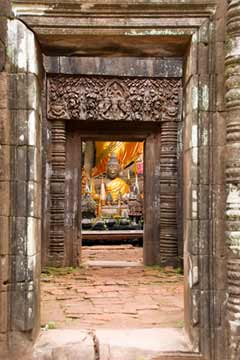
An interesting visit whilst in Laos are the ancient ruins of the Khmer temple of Wat Phou, which are located on the Mekong river and is a Unesco World Heritage site.
Dedicated to Shiva, one of the Hundi Trimurti, the temple was built in the 11th century and is located at the base of Phu Kao mountain that rests along the Mekong river delta. Because of this the Buddhist monastery is referred to as the Mountain Temple and also Lingaparvata, which is due to the mountain having a rock formation on the summit that resembles a Linga, which represents the God, Shiva.
To get to Wat Phou it is recommended that you take a river cruise from Pakse, easily arranged through travel agents in the town and with many stops along the route. Minivans are also available, though they do not offer the same idyllic scenery. The drive is about 45km and will take you to the base of the mountain in, roughly, an hour.
This temple complex is thought to have been constructed during the late 10th and early part of the 11th century, outdating Angkor Wat by almost 100 years and built during the early period of the rise of the Kampuchean empire.
Whilst the temple complex is very well preserved, the surrounding cities of Lingapura and Shrestrapura are in much decay. Some water reservoirs still exist in the surrounding areas, however. These reservoirs, or Barays, were built by the Khmer inhabitants and represent the oceans that surrounded Mount Meru, which is a foundation of Buddhist belief.
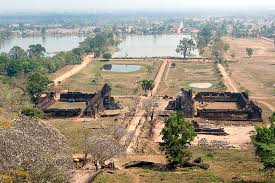
There is still a causeway to the South that leads to Angkor, which was the capital of the Khmer empire at the time. Though the structure is vast it is quite easy to navigate. From the main sanctuary, you can easily walk towards the river, passing the two grand palaces, down the main causeway and Barays to eventually arrive at the Mekong’s banks.
Unesco maintains that the Phu Kao mountain, the temple area itself, with its terraced levels and the earlier cities are all Heritage Sites and are protected.
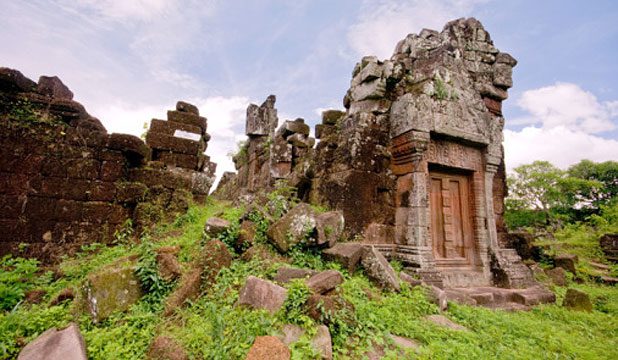
A long processional walkway, with guided avenues, leads from the Barays towards the main Wat. Halfway down the ceremonial precession area are the remains of the two palaces, to the south is the Ho Thao and the Ho Nang to the North. Though called palaces, their actual purpose has not been verified with certainty. It is commonly thought that the 11th century buildings were used for early Hindu ceremonies. The lintels and pediments on the two palaces are adorned with intricate carvings of Shiva and his consort Uma on Nandi, the sacred bull. Near Ho Thao is a shrine dedicated to the sacred bull Nandi, Shiva’s companion and transport.
The main ceremonial area contains the Linga, which is meant to represent Shiva. There is a mountain spring that channels towards the Linga in the main ceremonial section, its holy water continuously flowing past the Linga. The ceremonial site now hosts a more recent seated Buddha with three smaller, saffron clothed, Buddha figures presented in front.
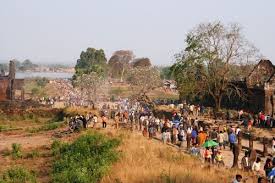
The annual Boun Wat Phou Champasak, is held every year at the temple, which is referred to as the Vat Phou Festival. The dates of the next Vat Phou Festival in 2019 will start on the 17th of February and culminate on the 19th of February.
During the 3 day festival, many food stalls line the main thoroughfares, with many thousands of visitors entering the Wat. The festival is held on Makha Bucha day, during the full moon of the 3rd lunar month. The attendees come to pay respect to the Buddha and bring offerings. Traditional Lao dancers, traditional music, and games are the fare of the celebrations.
There are many layers of terraces on the site. The largest is 60 x 60 meters in area for the ceremonial area that is dedicated to Shiva. The terrace lies about 70 meters higher than the Barays, offering great views over the plains.
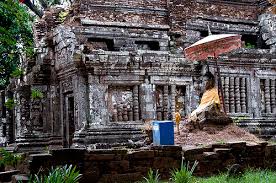
One of the other terraces, which contains the main ceremonial area, has 6 towers that surround the main promenade. These hold many different idols, including a representation of a Linga and guardians called a Dvarapala on different terraces.
Many of the buildings are sculptured with renditions of Devatas, Apsaras, Dvarapala guardians and Kalas, a monster usually depicted without a lower jaw. The eaves are adorned with various sculptures which include Vishnu on Garuda, Krishna killing Kansa, Indra riding the three headed elephant, Airavata, Krishna defeating the Naga Kaliya and stories from the Ramayana, like the abduction of Sita.
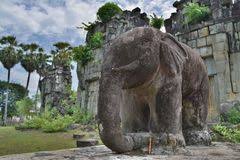
Near the main ceremonial area are two large boulders carved to resemble an elephant and a crocodile along with a rock carving of the Hindu Trimurti representing the three Gods Brahma, Vishnu and Shiva.
Public transportation to the temple area is not the most convenient, but is quite possible. You can take a songthaew which will take at least an hour. You can get a ticket from most markets in Pakse and even travel agencies around the Daoruang Market. The price varies from 80,000 to 120, Kip. You may also let a motorbike, but check the route first and expect to pay around 80,000 Kip for a day. Again, it will take about an hour to make the trek. Renting a bicycle or a tuk-tuk are also options. The bicycle will take quite some time, however.
The temple complex opens daily from 8 am until 4.30 pm. Admission is 30,000 Kip per person. A 45,000 Kip ticket includes a ride by golf kart to the entrance gate of the temple, which is less than 1 kilometre away.
